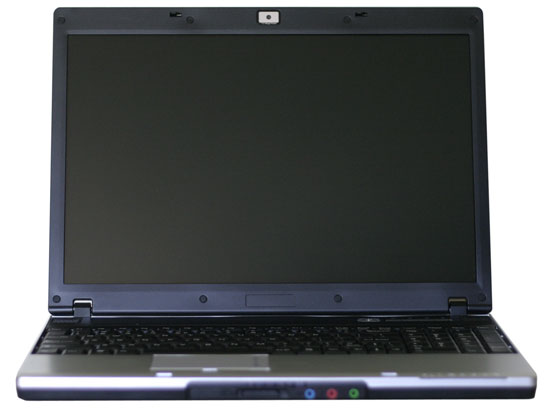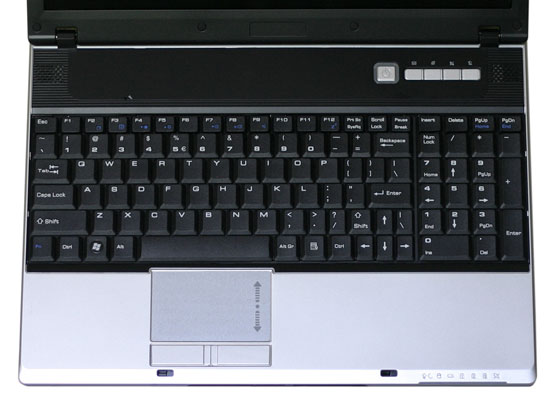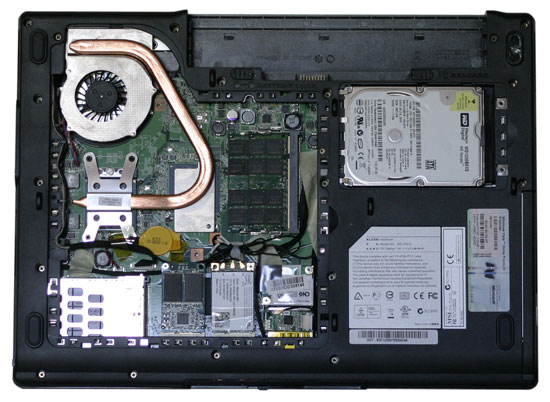PC Club Enpower ENP660: Back to School
by Jarred Walton on August 14, 2007 7:00 AM EST- Posted in
- Laptops
Design and Appearance (Cont'd)
As stated, there's nothing particularly noteworthy about the design or appearance. This is your standard laptop, and it does exactly what you would expect a laptop to do. A 1.3 MP webcam sits above the display, which we found to be pretty much the same as any other laptop webcam that we've used. It will work for videoconferencing, low-quality YouTube videos, or if you're really desperate you might try to re-create the Blair Witch Project. (Move along; nothing to see here....)
If there's one standout feature of this laptop, it would have to be the keyboard. You can find basically everything else in a dozen similar laptops that all have a similar price. A15.4" notebook with a full-size keyboard with a number keypad, on the other hand, is a bit more unusual. There is a drawback to the inclusion of the numpad, which you can easily see in this photo. Since the number keypad takes up the right portion of the keyboard space, the standard QWERTY keys get shifted over to the left, along with the touchpad. This is again one of those things that will come down to personal preference, but we had no problem adapting to the off-center location of the keyboard, and we were quite happy to have a numpad. Our only gripe with the keyboard layout is that you have to use the function (Fn) key to access the Home and End keys in the top right. We would prefer to have those keys swapped with the Scroll Lock and Pause/Break keys instead, as we almost never have need of the latter. And again, we personally would prefer to have the Fn key swap places with the Ctrl key.
The bottom of the notebook has one large compartment that gives access to most of the insides, and the second compartment on the right is home to the hard drive.
Removing the covers, we are greeted with easy access to most of the components we might want to upgrade. Looking at the CPU cooler area, it almost appears that you could change out CPUs without having to completely dismantle the case; alas, appearances are deceiving and you will need to remove the remaining 16 screws in order to remove the plastic shell if you want to perform that upgrade. Pretty much everything else can be changed out, though. Of particular note is that you get not one, not two, but three mini PCI slots. All of these are in use, but it's still interesting to see that many slots in a notebook. The left slot contains the TurboMemory module, the middle slot is the Intel WiFi adapter, and on the right is the Bluetooth module. The DDR2 SO-DIMM slots are located above the mini PCI slots, and the hard drive is all alone under separate cover in the top right. Note that the laptop does require a SATA hard drive.
At present there is only one battery size available, and it's a 6-cell 51.8 WHr battery. That's a pretty average battery size, and for most midrange notebooks that means you should get a maximum of about 2.5 hours of battery life. Since the battery slides out the back of the laptop, there's definitely potential for MSI to create a higher capacity battery in the future, which is something we hope they do. Not everyone needs long battery life, but for those that do it's nice to have the option of choosing between a lighter laptop and one that has more battery power.
As a whole, the ENP660/MS-1637 is a decent design. We only have two major complaints. First is the inclusion of a VGA port rather than a DVI port; almost everyone uses LCDs these days, and we would prefer a digital output rather than an analog output (plus DVI outputs can be made backwards compatible with a VGA adapter). For most people, this is only a minor gripe. The other complaint is the LCD resolution (and as we will cover momentarily, the quality). Some users might like the 1280x800 native resolution, but we would definitely appreciate the option to get a 1440x900 or 1680x1050 panel in a 15.4" chassis - and other people out there would actually go so far as to want 1920x1200. However, this is a moderately sized laptop that targets the entry level/midrange sector, and the design decisions (and our complaints) reflect this fact. Adding a few more features and a better LCD might be appreciated by some people, but it could also very likely push the price out of reach of many others.
 |
As stated, there's nothing particularly noteworthy about the design or appearance. This is your standard laptop, and it does exactly what you would expect a laptop to do. A 1.3 MP webcam sits above the display, which we found to be pretty much the same as any other laptop webcam that we've used. It will work for videoconferencing, low-quality YouTube videos, or if you're really desperate you might try to re-create the Blair Witch Project. (Move along; nothing to see here....)
 |
If there's one standout feature of this laptop, it would have to be the keyboard. You can find basically everything else in a dozen similar laptops that all have a similar price. A15.4" notebook with a full-size keyboard with a number keypad, on the other hand, is a bit more unusual. There is a drawback to the inclusion of the numpad, which you can easily see in this photo. Since the number keypad takes up the right portion of the keyboard space, the standard QWERTY keys get shifted over to the left, along with the touchpad. This is again one of those things that will come down to personal preference, but we had no problem adapting to the off-center location of the keyboard, and we were quite happy to have a numpad. Our only gripe with the keyboard layout is that you have to use the function (Fn) key to access the Home and End keys in the top right. We would prefer to have those keys swapped with the Scroll Lock and Pause/Break keys instead, as we almost never have need of the latter. And again, we personally would prefer to have the Fn key swap places with the Ctrl key.
 |
The bottom of the notebook has one large compartment that gives access to most of the insides, and the second compartment on the right is home to the hard drive.
 |
Removing the covers, we are greeted with easy access to most of the components we might want to upgrade. Looking at the CPU cooler area, it almost appears that you could change out CPUs without having to completely dismantle the case; alas, appearances are deceiving and you will need to remove the remaining 16 screws in order to remove the plastic shell if you want to perform that upgrade. Pretty much everything else can be changed out, though. Of particular note is that you get not one, not two, but three mini PCI slots. All of these are in use, but it's still interesting to see that many slots in a notebook. The left slot contains the TurboMemory module, the middle slot is the Intel WiFi adapter, and on the right is the Bluetooth module. The DDR2 SO-DIMM slots are located above the mini PCI slots, and the hard drive is all alone under separate cover in the top right. Note that the laptop does require a SATA hard drive.
 |
At present there is only one battery size available, and it's a 6-cell 51.8 WHr battery. That's a pretty average battery size, and for most midrange notebooks that means you should get a maximum of about 2.5 hours of battery life. Since the battery slides out the back of the laptop, there's definitely potential for MSI to create a higher capacity battery in the future, which is something we hope they do. Not everyone needs long battery life, but for those that do it's nice to have the option of choosing between a lighter laptop and one that has more battery power.
As a whole, the ENP660/MS-1637 is a decent design. We only have two major complaints. First is the inclusion of a VGA port rather than a DVI port; almost everyone uses LCDs these days, and we would prefer a digital output rather than an analog output (plus DVI outputs can be made backwards compatible with a VGA adapter). For most people, this is only a minor gripe. The other complaint is the LCD resolution (and as we will cover momentarily, the quality). Some users might like the 1280x800 native resolution, but we would definitely appreciate the option to get a 1440x900 or 1680x1050 panel in a 15.4" chassis - and other people out there would actually go so far as to want 1920x1200. However, this is a moderately sized laptop that targets the entry level/midrange sector, and the design decisions (and our complaints) reflect this fact. Adding a few more features and a better LCD might be appreciated by some people, but it could also very likely push the price out of reach of many others.










11 Comments
View All Comments
Kayaker123456 - Friday, December 28, 2007 - link
Be careful of buying anything from PC club. I took a computer and brand new case in for work and both cases were damaged. They stripped the alumium screws out on my Lian Li case and screwed in steel ones that stripped the holes. The black piano mirror finish on the Antec Solo case was scratched. Spoke to corporate and was told that they are not responsible. The have a poor rating by the BBB as they do not respond to complaints.Dadoftwo - Wednesday, August 15, 2007 - link
In your opinion, what is the best notebook/laptop money can buy, under $1000? Primary purpose would be for my daughter, a soon-to-be freshman in college majoring in accounting.JarredWalton - Thursday, August 16, 2007 - link
Look at some of the Turion X2 offerings. HP has some that come in at under $1000 with quite a few upgrades. The V6000Z for example - get a 1.8GHz CPU, 2GB RAM, and Office Basic 2007 for right around $1000. Dell's Inspiron 1521 is also pretty decent, and you can get a better LCD (say 1440x900 or 1680x1050) with 2GB and spend right around $1000. Basically, laptops don't tend to give companies a lot of ways to differentiate on the low end. Most $1000 or under laptops will end up being relatively similar - you can add memory and get a smaller HDD, or get a nicer LCD but have less RAM, or some other tradeoff.daytex5 - Wednesday, August 15, 2007 - link
Did the reviewer actually TYPE on the keyboard? After purchasing the the ENP660, I was initially impressed with the board's solid feel, but was quickly frustrated that such a broad case would include a compressed keyboard. Many of the right side keys (Backspace, Enter, period, etc.) are half-size or smaller. Even worse, the right-side Shift key is the size of a standard letter key making it difficult to hit. Whoever made the decision to include the ten-key numeric keypad was not keeping the target audience in mind.
JarredWalton - Thursday, August 16, 2007 - link
I used it quite a bit. It's a personal preference, obviously. The point is, outside of the keyboard there's really nothing else that separates this laptop from other laptops with a similar price and features - except for example the dv6500t is actually $125 cheaper. I like the numeric keypad, and I tend to use the left shift when typing. I was never bothered by the slightly smaller key size or the off-center location of the keys. However, I am sure plenty of people would feel differently.IntelUser2000 - Tuesday, August 14, 2007 - link
It says on Page 13: "At times we even see the CPU exceed its normal 1.80GHz clock speed, and likewise the memory runs a little faster than DDR2-667. However, this only occurs for short periods of time and the system stability was never compromised by the changing frequencies."If you paid attention to the Santa Rosa platform, you'll definitely notice that the increased speed isn't the side effect, but a new feature. Santa Rosa platform has Enhanced Dynamic Acceleration Technology, which allows core speed to go up to one bin when one of the two cores are inactive.
I didn't know it also changed the FSB frequencies though.
JarredWalton - Wednesday, August 15, 2007 - link
The thing is, these are very short changes (like less than .5 seconds), and they occur when the system is only moderately loaded - like playing a WMV9 encoded movie in this case. It could be overclocking for Santa Rosa, but it's not even 1 bin. It's overclocking because the FSB is running at 350 MHz instead of 333 MHz for a brief moment. I realize Santa Rosa allows OC'ing of one bin, but for that I would expect a one bin increase.strikeback03 - Tuesday, August 14, 2007 - link
Have you tested ASTRA32 on any other laptops which definitely have a newer/better panel? Unless HP uses the same OEM as the MSI barebones system, it would seem odd that there is that large a stock of old AU Optronics LCD panels laying around.JarredWalton - Tuesday, August 14, 2007 - link
The most recent LCD manufacturing date that I've seen on a laptop came with the Gateway E-155-C (Jan 2006). However, I wouldn't be surprised if AU Optronics had a bunch of old inventory that they clearanced, which could then be used in laptops to keep prices down.Astra32 reports March 2006 on a Dell 3000WFP and December 2006 on an HP LP3065. It definitely does report more recent dates, then, but is it truly accurate? It might be wrong, but AUO does make a lot of LCDs, and the performance of the MSI/PC Club LCD leaves a lot to be desired. I find it hard to imagine that a more recent LCD would have a black level of nearly 1.0 nits.
AUO also has a list of panels they produce, http://www.auo.com/auoDEV/products.php?sec=noteboo...">found here. The panels used in both the HP and MSI notebooks (and a couple other notebooks) don't show up in that list, though later version are there. At the very least, I thinks it's safe to say that the LCD used is an older model. 30 months old? Maybe not, but then why continue to use a 1280x800 panel on a new laptop if not for price reasons?
madonna grey - Wednesday, October 21, 2020 - link
I have been looking for this information for a long time. By the way, recommend a laptop that will be very convenient for studying.